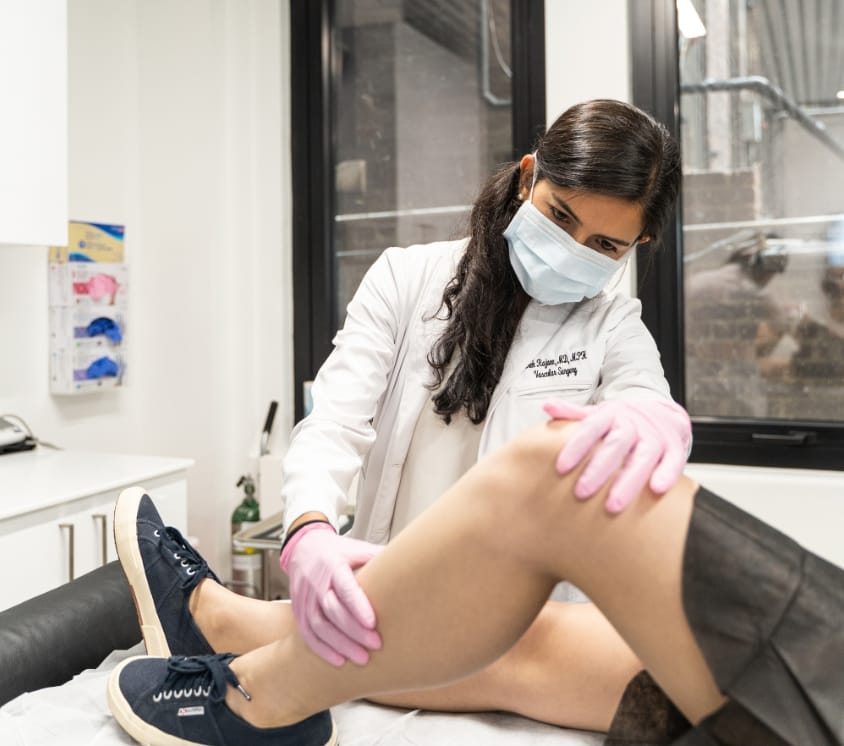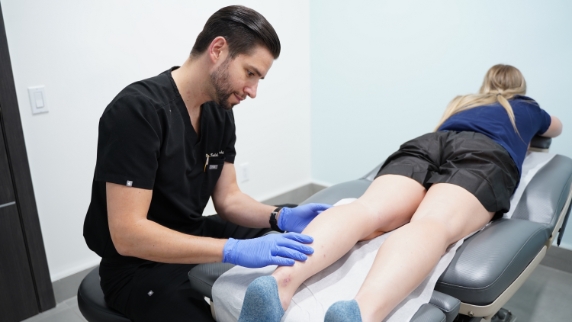How To Cure Varicose Veins
Varicose veins and spider veins are more than an unattractive inconvenience. Often, they are the first visible sign of underlying vein disease. As the condition worsens, you may notice other symptoms, like leg cramps, swelling, aching, and heaviness. Fortunately, your vein doctor in New York or vein doctor in New Jersey knows how to cure varicose veins using safe, minimally invasive techniques that are virtually painless.

How to Cure Varicose Veins | Expert Advice from Vein Specialists
What Causes Varicose Veins?
When you think back to your biology and human anatomy classes, you probably remember images of the circulatory system that showed a network of red and blue lines throughout the body. However, none of the drawings or photos you have seen can truly capture how extensive and intricate the network of blood vessels is. If all of the blood vessels in an adult’s body were laid end-to-end, they would stretch nearly 100,000 miles.
The red lines on those images represent arteries, and the blue lines represent veins. Arteries carry oxygenated blood from your lungs to your organs and tissues. Once the oxygen has been delivered, veins move the deoxygenated blood back to your heart, where it is pumped to your lungs to pick up a fresh supply. From there, the cycle starts all over again.
Veins have a harder job than arteries, because they are transporting blood from the lower part of your body to the heart. They are working against gravity to accomplish this goal. Veins rely on a series of one-way valves to ensure that blood moves in the right direction. The valves open for blood to pass through, then they close to prevent backflow.
Injury or disease can damage the valves in your veins, allowing blood to leak backwards. When this happens, the blood pools in the lower half of your body, creating pressure inside the veins. This extra pressure causes damage to vessel walls, and it can harm more valves, which makes the problem worse. Veins begin to swell, and if they are located close to the surface, they may protrude against your skin. These bulging veins are referred to as varicose veins. They look like thick, twisted ropes, which causes many patients to feel self-conscious about the appearance of their legs.
The most common reason people develop varicose veins is a disease known as Chronic Venous Insufficiency or CVI. Unfortunately, CVI frequently goes undiagnosed. General practitioners and physicians in specialties like dermatology tend to focus on how to cure varicose veins and spider veins instead of diagnosing and treating the underlying issue.
If you are experiencing varicose veins and related symptoms, it is critical to schedule a visit with an expert vein doctor in NY or vein doctor in NJ to ensure that you get the right treatment for your particular situation.
What are the Symptoms of Vein Disease?
Though you might be focused on how to cure varicose veins and spider veins, a skilled vein doctor will be concerned with the other symptoms you are experiencing as well. Some of the symptoms to be aware of include sudden, painful leg cramps, which often occur at night. Patients may also develop Restless Leg Syndrome, which is a compulsive need to move or stretch the legs. Both of these issues are disruptive to sleep.
Many people with CVI notice aching, swelling, and heaviness in their legs. This may feel a bit better when legs are elevated. The swelling can lead to changes in the skin, such as itchiness and sensitivity. In advanced cases, you might see discoloration of skin around the ankles. The discolored skin is often quite fragile, and the slightest scrape or scratch can cause a wound that is slow to heal. Unfortunately, this leaves the skin open to bacterial infections like cellulitis.
Who is at Risk for Varicose Veins?
Varicose veins are most common in people over the age of 50, and they affect women more often than men. However, individuals under the age of 50 are not immune from this condition. Many pregnant women develop varicose veins in buttocks and legs. There is a strong genetic link when it comes to vein disease, so your risk is higher if you have a family history of varicose veins.
Certain lifestyle factors can heighten your risk of vein disease. For example, smoking and obesity are often associated with this condition. Spending long periods sitting or standing can increase the likelihood of varicose veins, as well.
How to Cure Varicose Veins?
At one time, it was necessary to visit a vascular surgeon if you wanted to know how to cure varicose veins. The only available treatment was invasive vein stripping surgery, which required full anesthesia and a hospital stay. Today’s treatments are less invasive and more effective. Most can be performed on-site at your vein treatment clinic in less than an hour, and you can typically return to your normal activities the same day.
Current varicose vein treatments are designed to permanently close unhealthy veins, which automatically prompts blood to be rerouted through healthier veins. The closed vessels are reabsorbed by your body, eliminating the unsightly varicosities.
After applying a local anesthetic, your vein doctor accesses the vessels being treated through one or more small incisions in the skin. Usually, these incisions are so minor that you don’t even need stitches. Procedures take from 15 – 45 minutes to complete, and very little recovery time is necessary. Patients typically wear compression stockings for a few days following the treatment.
The most popular methods of closing unhealthy veins include the following options:
- Sсlеrоthеrару – Uses a medical injection to close varicose veins
- VenaSeal – Seals diseased veins with a medical adhesive
- Radiofrequency Ablаtіоn (RFA) – Relies on thermal energy to close unhealthy veins
- Endоvеnоuѕ Lаѕеr Ablаtіоn (EVLA) – Applies targeted laser energy to close unhealthy veins
- Clarivein – Uses an advanced tool to administer medication for closing varicose veins
- Varithena – Uses a medical foam to close varicose veins
The Board-Certified physicians at the Vein Treatment Clinic specialize in diagnosing and treating vein disease. They have experience with the most advanced treatment methods, and they work with you to select the procedure that best fits your unique needs. You can schedule a consultation online or by calling (844) 690-1788.













